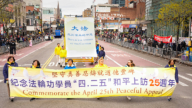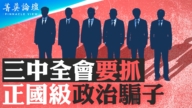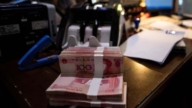【新唐人2011年5月3日讯】中国媒体报导,安徽省电力公司为了推动“车改”,特别帮300名干部配车,虽然安徽电力说这为公司降低了管理成本。不过媒体质疑,每人一辆自驾车,真能为公司省钱吗?
上周末(4月30号)《浙江在线新闻》报导,安徽省电力公司近年来为了推动“车改”,特别帮300名副处级以上的干部配备公务自驾车,而且配车越来越豪华。从早期的国产奇瑞汽车,到现在价值20万元有德国血统的一汽大众迈腾汽车。
虽然安徽电力急忙解释:“车改”为公司降低了管理成本。不过媒体质疑,每人配一辆自驾车,全部费用还由公司负担,怎么帮公司省钱?”
报导指出,安徽电力为干部配备公务自驾车,说白了就是给公司管理阶层配车。公司的理由更是让人难以接受,现在一人配一辆自驾车,虽然是节省了公交车司机的工资费,但是,谁规定干部回家一定要派公交车接送?而且多人搭一辆公交车回家,通常会比每人配一辆自驾车省钱。
《中国评论》的报导也指出,大约从1996年开始, 中国开始出现公交车特权化的现象。中共政府及各部门处室运用各种理由给官员配车。于是各地方政府上行下效,凡是副科级以上领导干部,几乎每人配一辆公务车,官员上下班,或下班后迎来送往全部免费开公交车。
根据估计,每辆公务车每 年要花至少3到5万,甚至8万到10万的人民币,一个省级厅局一年的公务车预算约200万元,省级公有单位的公务车辆,每年花费国家2亿元,加上国有企业,每个省每年的公交车花费大约50到60亿。也就是说,全国每年公交车花费高达人民币 2000亿元。
台湾《新新闻》周刊在4月底刊登中国知名评论家长平的文章,其中向外界解释中国的“公交车”,跟民主国家的公交车概念不完全相同。外国的公交车,是指供大众使用的“公交车”。而在中国,虽然也有少数的公交车在跑,但中共官方文件会玩文字游戏,把“公务用车”简称为“公交车”,意谓着把官员享有的“特权”,变成了社会大众的公共事务。
文章还说,官员们的“公交车”数量远超过一般民众的“公交车”。2006年北京中非论坛期间,官方为了保障外国人交通便利,主动对“公交车”进行数量控制,还对媒体公布,北京巿百分之60的“公交车”暂时封存,约为49万辆。加上五年来的成长,网友估计北京巿的“公交车”数量应该接近一百万辆。。
新唐人记者曾耀贤、周昕屹综合报导。
Cars for Chinese Officials
In the name of promoting a “vehicle reform",
Anhui Electric Power Company (AEPC)
assigned 300 cars to communist party (CCP) cadres,
citing reduction of administrative costs.
However, the media questioned the rationale.
On April 30, Zhejiang Online News reported,
Anhui Electric Power Company (AEPC) assigned
expensive cars to 300 high-level CCP cadres.
Previously it assigned Chinese-made Chery cars.
Now they are FAW-Volkswagen Magotan cars,
which are worth RMB 200,000 each.
Although AEPC immediately explained that
the “vehicle reform" is to reduce administrative costs,
the media questioned, how can AEPC save money
by equipping the cadres with company-paid cars?
The media criticized its unacceptable explanation.
With each cadre driving a company-purchased car,
although the salary costs of chauffeurs can be saved,
who said the cadres have to use the company’s cars?
Also, multiple cadres sharing one company car
is more money-saving than assigning one car to each.
China Review magazine pointed out that in 1996,
the phenomenon of car privileges started to appear.
CCP authorities and agencies use various reasons
to assign vehicles to CCP officials.
So all the local governments follow their example
by giving officials cars paid by the public or firms.
It is estimated that the annual expenses on one car
are from 30,000 yuan to 100,000 yuan.
One provincial bureau spends nearly 2 million yuan.
The total costs on equipping cadres with cars in China
are 200 billion yuan every year.
Taiwan’s The Journalist magazine published in April
an article by Chinese commentator Chang Ping.
In the article, he talked about the term “public vehicle”.
In democratic countries, “public vehicles” are buses.
In China, although omnibuses exist,
“public vehicles” are defined as “cars for public use”.
CCP’s official papers try to play words by
portraying officials’ privileges as “for public works”.
Chang Ping also pointed out that in China,
there are more cars for cadres than buses.
When Beijing hosted the 2006 China-Africa Forum,
to make the traffic better for the foreign visitors,
the authorities temporarily suspended 490,000 buses,
which were approximately 60% of all buses in Beijing.
Netizens estimated there are 1 million buses in 2011.
NTD reporters Zeng Yaoxian and Zhou Xinyi




























